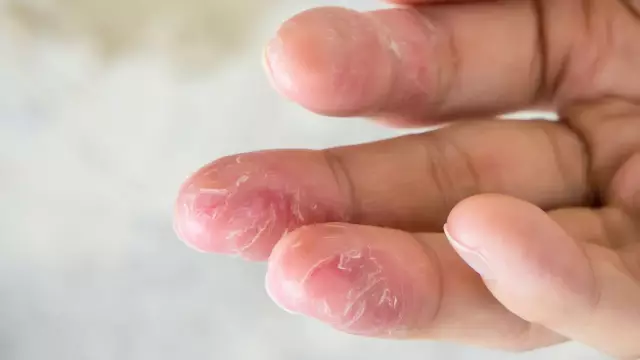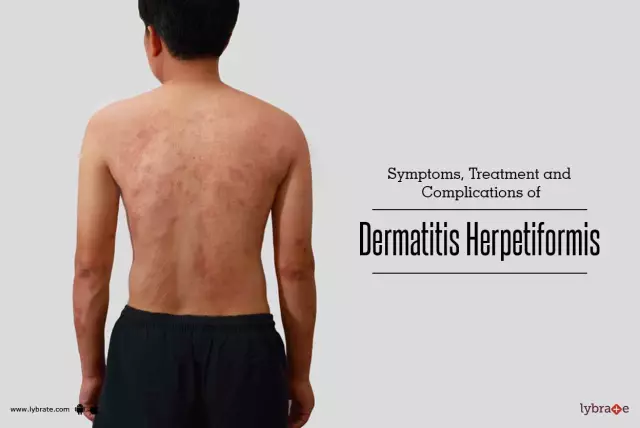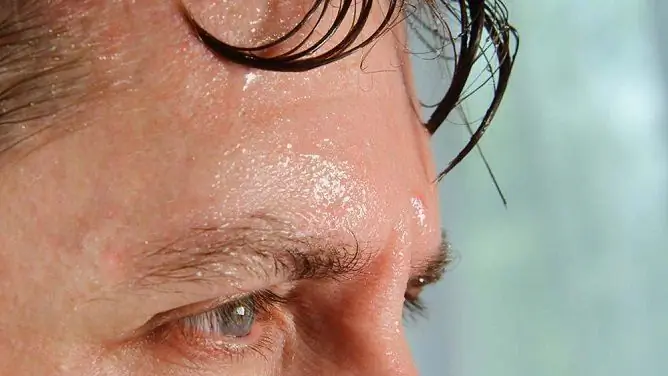- Author Rachel Wainwright [email protected].
- Public 2023-12-15 07:39.
- Last modified 2025-11-02 20:14.
Contact dermatitis

Contact dermatitis is an inflammation that occurs due to contact with an allergen. A contact dermatitis rash is limited to one area and is often clear-cut.
Contact dermatitis symptoms
The symptoms of contact dermatitis begin with mild, short-lived redness and end with severe swelling and blistering. Often, the rash is tiny itchy blisters. At the very beginning, the rash may be limited to the site of contact with the pathogen, but later it can spread to nearby skin areas.
The area of the rash may involve large areas of the skin (for example, if contact dermatitis is caused by a body cream) or be localized (for example, over the earlobes if earrings caused contact dermatitis).
If the irritant is removed, the redness usually goes away within a few days. Sometimes the bubbles can get wet and crusty, but they dry out quickly enough. But itching, flaking, and temporary thickening of the skin can persist for several days or weeks.
Contact dermatitis causes
Contact dermatitis is caused by allergens. They can cause inflammation in the form of irritation (simple contact dermatitis) or an allergic reaction (allergic contact dermatitis). Even the lightest detergents, soaps and some metals can cause inflammation if they come into contact with the skin frequently. Sometimes the constant exposure to ordinary water can dry out and irritate the skin. Immediately (in a few minutes) irritation can be caused by strong irritants (for example, alkalis and acids contained in detergents) and some organic solvents (for example, acetone in nail polish remover).
In allergic contact dermatitis, the initial or the first few contacts with an irritant may not provoke inflammation, but further contacts cause dermatitis and itching for four to twenty-four hours. It happens that people are in contact with certain substances for many years and they do not cause them any irritation, but then, suddenly, an allergic reaction appears. Even those creams and ointments that are used to treat contact dermatitis can cause such a reaction. Approximately 10% of women are allergic to nickel, which is found in jewelry. A distinction is also made between occupational contact dermatitis, which arises from contact with certain materials at work.
Diagnostics

Determining the cause of contact dermatitis is often difficult, since we do not always remember what we came into contact with and, accordingly, what could cause a reaction. Often, localization of the first rashes helps to diagnose contact dermatitis.
Sometimes, if, even after asking the patient in detail, the doctor cannot determine the allergen, an application skin test is performed. During this procedure, some contact dermatitis-causing substances are applied to the skin and these substances remain on the skin for two days to see if a reaction occurs or not.
Contact dermatitis treatment
Contact dermatitis is treated by eliminating the irritant. As a rule, contact dermatitis resolves on its own after removal of the irritant. If this does not happen, potent creams or ointments containing glucocorticoids are prescribed. If the face and genitals are affected and the rash continues to spread, oral medications containing glucocorticoids are also prescribed. The course of treatment is from two to three weeks, since relapses will inevitably occur if consumed for less time. The drugs are taken once a day in the morning.
To avoid infection, the affected area should be washed periodically with plain water and a mild soap. Do not open the vials. Dry dressings can also be used to protect against infection.
YouTube video related to the article:
The information is generalized and provided for informational purposes only. At the first sign of illness, see your doctor. Self-medication is hazardous to health!






